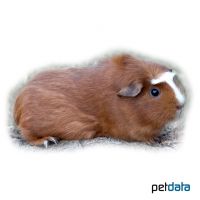White Crested Guinea Pig (Cavia porcellus 'Crested')
| White Crested Guinea Pig Cavia porcellus 'Crested' | |
|---|---|
| Name | White Crested Guinea Pig |
| Name Lat. | Cavia porcellus 'Crested' |
| Family | Cavies |
| Family lat. | Caviidae |
| Order | Rodents |
| Order lat. | Rodentia |
| Origin | South America (breeding variety) |
| Climate | Temperate |
| Habitat | Grassland |
| Diet | Hay, herbs, veggies |
| Behavior | ♂ semi-aggressive |
| Keeping | Pair, group |
| Care Level | Easy |
| Life Span | 4-8 years |
| Protection | No |
| Metric Units | |
| Size | Up to 1.8 kg |
| Temperature | Room temperature |
| Housing | 120 x 60 x 50 cm |
| US Units | |
| Size | Up to 3.6 lb |
| Temperature | Room temperature |
| Housing | 45" x 25" x 20" |
Distribution and habitat
The Crested guinea pig is a breeding form of the animals living wild in the high plateaus and bush steppes of the Andes. They were already kept as pets by the Incas and came to Europe in the 16th century with Dutch sailors
Cage size
The cage size should be at least L 120 x W 60 x H 50 cm for a pair and should not be less than this even when kept singly. For group housing, the enclosure should be extended accordingly. The cage should be placed in a bright (no direct sunlight), draught-free and quiet place and have cross-wiring, with a grid width that excludes injuries. Terrariums or aquariums are unsuitable for keeping.
Maintenance
The basic equipment includes a hayrack covered at the top to prevent injuries, a house with a flat roof and at least two entrances for each animal, as well as hiding places (cork tubes, grass nests, hay houses, etc.). The floor must be evenly covered with absorbent litter (small animal litter, hemp litter, beech granules, etc.) to prevent slipping and must always be kept clean and dry. Mineral cat litter is not suitable. Nail material (rodent stones, wood) must always be available to wear down their permanently regrowing teeth. Hard bread is not suitable as nail material. They should be kept at room temperature and their natural day-night rhythm should be respected.
Diet
They are herbivores and their basic food is hay, which must always be available in the best quality in a hayrack. In addition, they need vegetables (carrots, fennel, dandelion, etc.), some fruit (apples), minerals (rodent stone), sodium chloride (salt lick) and especially vitamin C (lettuce, spinach, rose hips) and commercial guinea pig food. Water must always be available in hanging bottles or in stable, open containers and, like food, must be offered fresh daily. Water and food containers should be arranged so that they cannot become soiled
A regular and varied diet promotes health and prevents deficiency symptoms.
Behaviour and compatibility
They have a strong need for social contact with conspecifics and should only be kept in pairs or in a group, such as a (neutered) buck with several females or a female group. Nevertheless, individual incompatibilities can occur, especially if sufficient retreat possibilities are missing or the space is too small. Neutered males are usually more compatible
Due to their different behaviors, guinea pigs should not be kept together with dwarf rabbits.
Reproduction and breeding
A light pressure with a finger just above the genital area makes a penis protrude in the male.
The female is in heat for about 8-11 hours every 14-18 days. The young are born fully developed after an average of 68 days. They are nest-fledglers, weigh between 60-120 g and already have fur, open eyes, can walk and nibble on hay, fruit and vegetables just a few hours after birth
Important
Among the shorthaired guinea pigs there are recognized breeds (e.g. Rex, Teddy, Rosetty, Curly, Smooth, Rosette) and also many mixed breeds.
Eating feces (appendix feces) is not a behavioral disorder but serves for vitamin B supply and must not be prevented. Since they cannot produce vitamin C themselves, they must cover their needs through food. They have very good hearing and are sensitive to noise. As escape animals they need sufficient retreat and hiding places, the cage should not be placed on the floor but somewhat elevated
You can find further literature in your pet store.
References
Text: petdata; Image: petdata
Source: W. PUSCHMANN, D. ZSCHEILE, K. ZSCHEILE (2009): Zootierhaltung - Tiere in menschlicher Obhut: Säugetiere, Harri Deutsch Verlag; Tierärztliche Vereinigung für Tierschutz e.V. (2011): Merkblatt für Tierhalter - Meerschweinchen
- Gemäß § 21 Abs. 5 Tierschutzgesetz idgF
